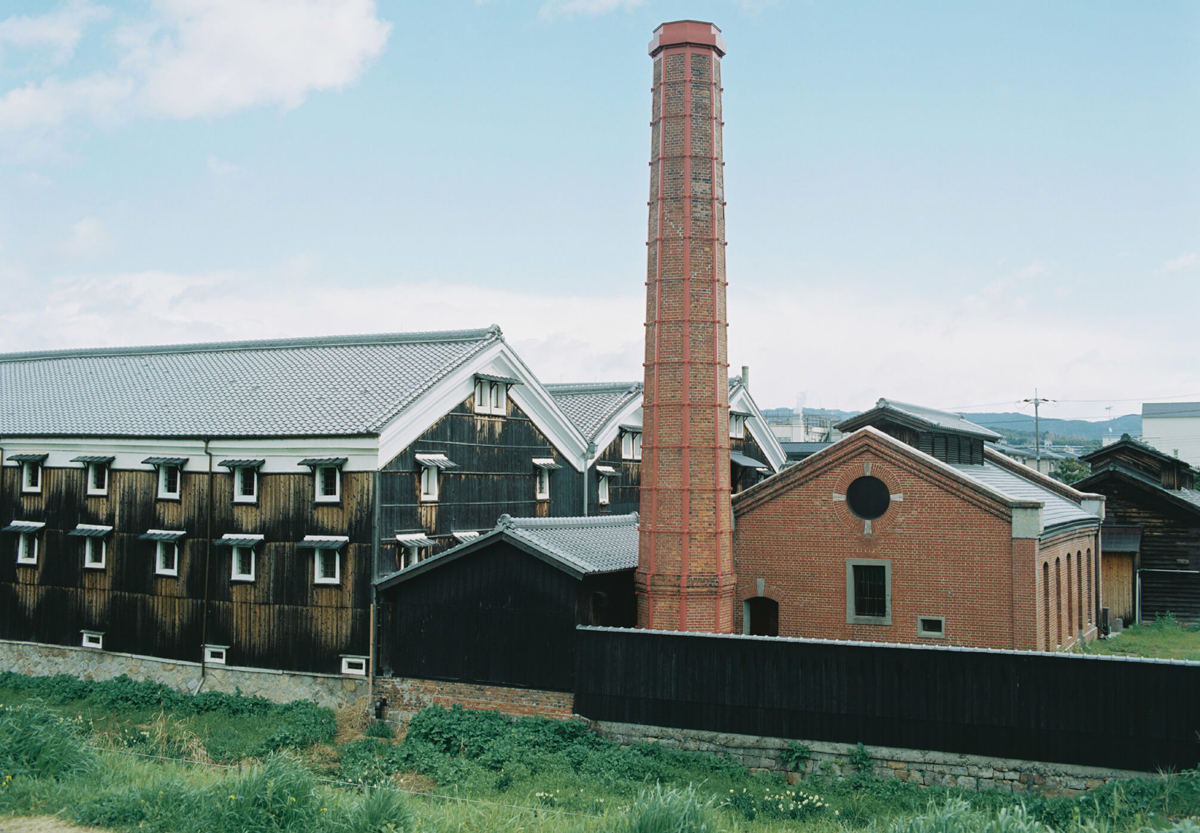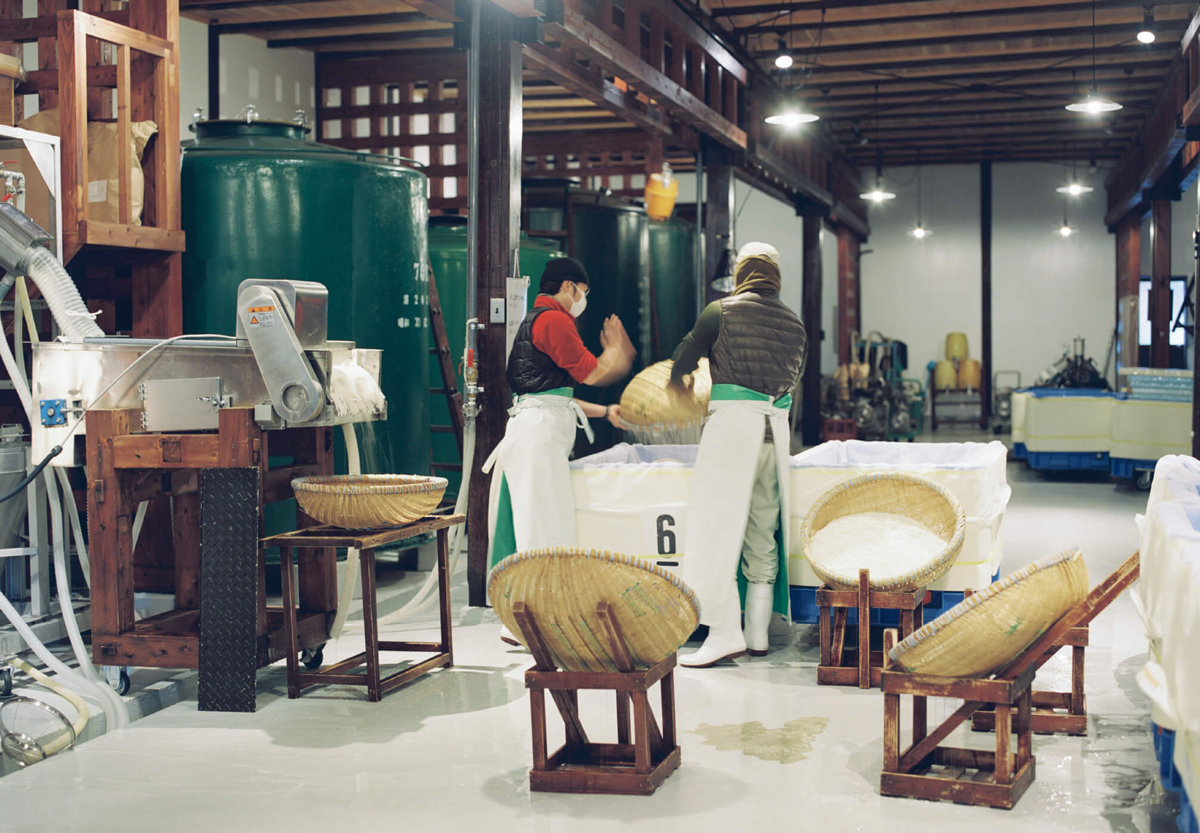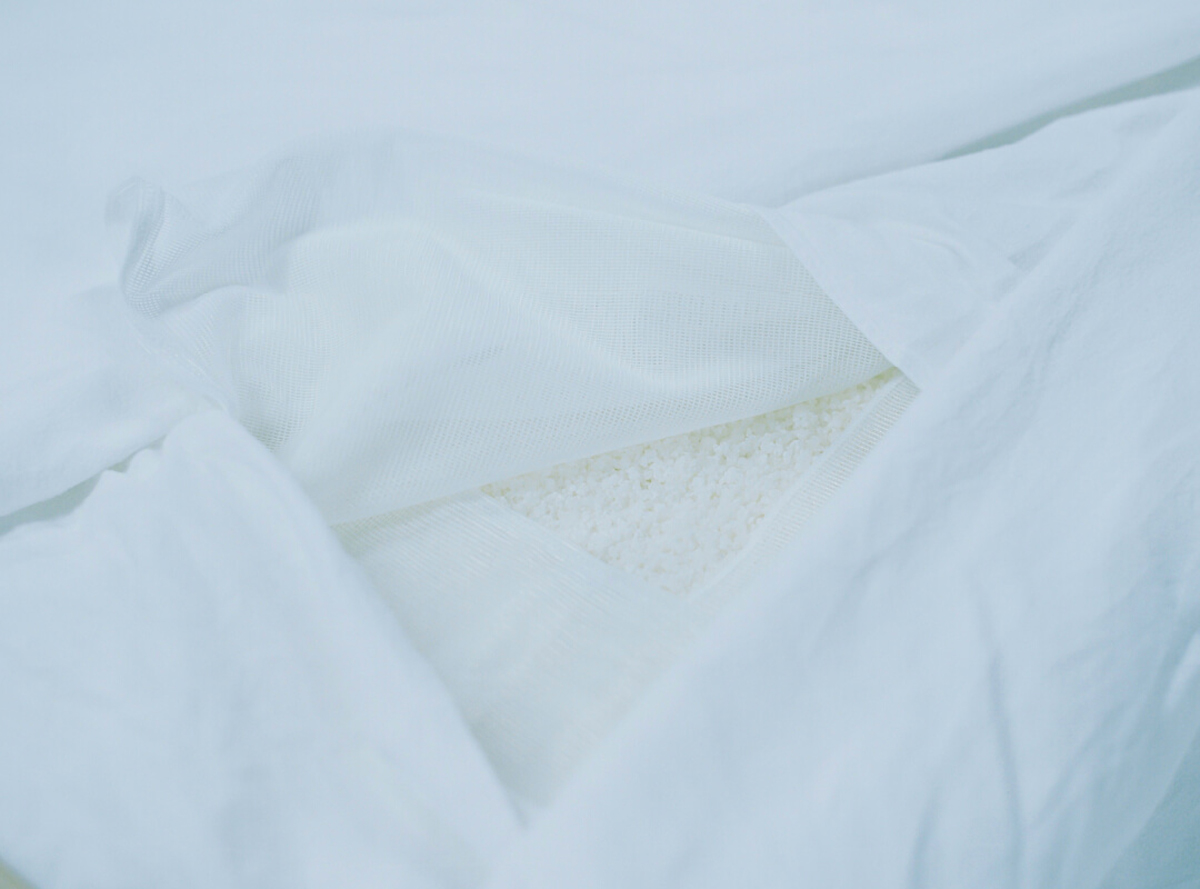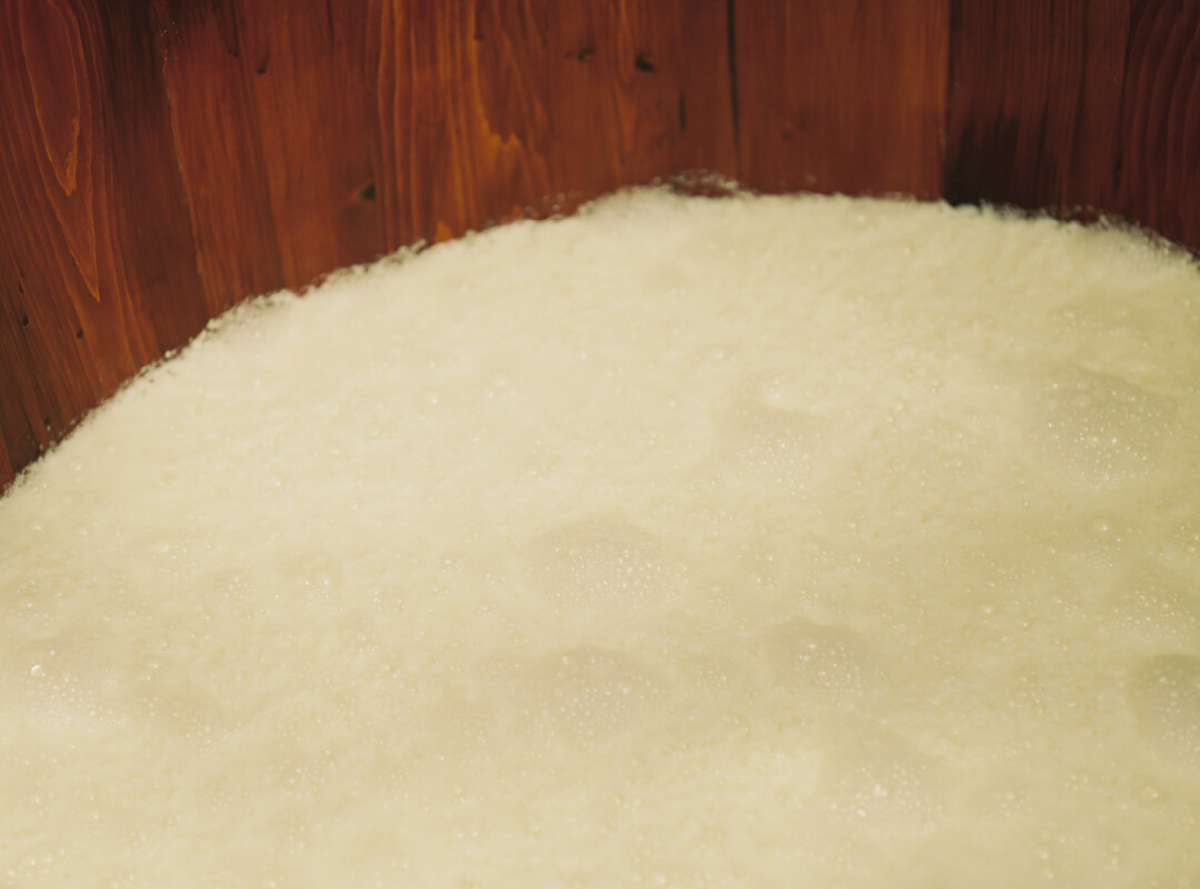不自然な京都の街から見出す本来の自然のあり方
自然は普通にあって当たり前の存在で、空気みたいなもの。でも実は一番大事だよね、と僕の人生の中で思っている。その一番大事なものを押し付けるのではなく、普段の生活の中で皆がちゃんと意識したり、その価値に感謝して生きていけば、きっと自然にも人にもいいと思うんですよね。
松本酒造は大正12年に京都市内からこっち(伏見)に移ったのですが、その理由は水でした。山に染み込んだ水は京都という盆地の特性で、大阪に向かって南西に動いています。そこにはまず、京都市内の豆腐屋さんや料理屋さんが使い、その使わなかった水で私たちが酒を造り、私たちが使わなかった水で大阪の蒸留所がウイスキーを作って………という自然の摂理がある。それはもう何千年も昔からずっと繰り返されてることで、私たちはその中の点のひとつとして存在している。
でも京都には元々自然はないんです。1200年間、30万人の人が住んで木を切り倒し続けて、材料も何もない場所に、献上品として、おいしい食材や反物や技術や人を揃えなくてはと、自然な流れで京都の外からどんどんものや人を入れたわけです。京野菜も元々は京都の外で育てたおいしい野菜を京都で育てたから「京野菜」と呼ばれるようになったんです。そういった歴史を経て京都にあるものって外から来たものばかりだから、ある意味不自然な街。でも、山に囲まれていているのでマイナスイオンで溢れていて、気持ちの良い場所でもある。それこそが自然体なんですよね。
Seeing the nature of nature in the unnatural city Kyoto
Nature is ordinary and natural, like air. But in my life I think it's actually the most important thing. Rather than imposing that most important thing, I think that if everyone lives in their everyday life with consciousness and appreciation for its value, it will surely be good for nature and people. Matsumoto Shuzo moved from Kyoto city to this place (Fushimi) in 1923, but the reason was water. The water that soaks into the mountains is a characteristic of the Kyoto basin, moving southwest toward Osaka. First of all, the tofu shops and restaurants in Kyoto city use it, we make sake with the unused water, and the distillery in Osaka makes whiskey with the water we do not use… There is a natural providence of…. It has been around for thousands of years, and we are one of them. But there is no nature in Kyoto. 300,000 people have lived and cut down trees for 1200 years, and in a place where there is no material, as a gift, delicious ingredients, cloths, techniques and people have to be prepared, and the natural flow of Kyoto That's why more and more people came in from outside. Kyoto vegetables were originally called "Kyoto vegetables" because they grew delicious vegetables from outside Kyoto and grew up in Kyoto. After all, the only thing in Kyoto that has come from outside is a kind of unnatural city. However, because it is surrounded by mountain

― 松本酒造といえば「原料に勝る技術なし」というスローガンにもあるように、地元京都で原料と技術にこだわった酒造りをおこなっており、自然の人の関係性は切っても切り離せない。いま松本さんが感じる酒造りにおいてどう自然を捉えているのでしょうか。
— As your slogan "No technology is better than raw materials” implies, you make sake locally in Kyoto focusing on raw materials and technology. The relationship between nature and people is inseparable. How do you perceive nature now in terms of the sake brewing?
自然に合わせて人も変化する松本酒造が考える“自然”な日本酒
いま、日本酒を造るという自然にあった概念がすごいスピードで崩れてきている。昔は「酒屋さんはお酒を造っていればいい」という価値観が、この5~10年の間に変わってしまったんです。「お酒を作れるのも美味しいのも当たり前。で、それで?」と突きつけられたときに、自分たちのブランディングやビジネスモデルを打ち出さないと売れなくなってしまった。その考えってすごく自然じゃないなと思ったんです。「自分たちのお酒はこうなんです」とモデルを作っても、人間だから変わっていく。自分たちが違うと感じていても、売れるためにはそのモデルを押し通さないといけないのかな……と悩んだことがありました。そんな時期、ある方に「軸は動かしていないと駄目だよ」と教えてもらったことがあったんです。例えばサッカーだと、日本人選手の一歩と外国人選手の一歩は全然違うから、軸足を動かさないと勝てないという話を聞いて、その考え方を自分の酒造りの中に落とし込んだとき、すごく楽になったんです。いわゆる自然体になれたというか。自然は変化するのだから、そこに人間も合わせて変化すればいいと思ったんです。
日本酒で自然体を表現しようとするとき、「何も手を加えずにありのままで発酵させること」が自然な日本酒だと思う人がたくさんいる。でも僕は、それは自然ではなくただ放置しているだけだと考えています。自然の恵みをありのままにするのではなく、そこから出てくる美しいものを切り出したり掘り起こすことが僕の考える自然な日本酒。そしてそれが自分の仕事だと思っています。その美しさを表現してはじめて、自然が皆さんの生活の中でいいと思ってもらえるものとして昇華できるんです。 松本酒造は来年230周年を迎えます。230年間京都で酒を造り続けていくとその過程で人間の感性も変わっていきます。お客さんも変わるし、造っている僕たちも変わる。その変わる過程の中で生まれるものが、皆にとっても、自然にとってもいいことで、私たちにとってもやりがいのあること、価値があることなんじゃないかなと。”三方よし”。そういういい感覚が繋がった時にはじめて、商売が継続できるのかなと思うんです。
People change adjusting to nature Matsumoto brewery’s idea of “natural” sake
What is our “natural” sake
These days, the traditional concept of making sake is breaking down at a tremendous speed. In the past a sake brewer was just supposed to make sake. But this way of thinking has changed in the past 5-10 years. Today it’s nothing special that you can make sake that tastes decent. You will be asked “and then?” So you have to work out your own branding and business model in order to sell. That didn’t seem very natural to me. Even if you make a model saying “this the way our sake is “, you will eventually change as a sake brewer because you are a human. Do you have to push through the model because you have to sell, even if you felt that something was not quite right? Like that I was really in doubt for a period of time. But at that time, one person told me that I had to move the axis. For example, in soccer, one step of a Japanese player and one step of a foreign player are completely different, so you have to move the pivot leg to win. I was eased when I applied that idea into my sake brewing. I could be just the way I was. Because nature changes, people should also change accordingly.
When you try to express a natural state with sake, many people think that letting it ferment without manipulating does the job. But don’t think that’s natural, that's just leaving it alone. Rather than just keeping the blessings of nature as they are, natural sake is about cutting out and excavating beautiful things that come out of nature. And I think that is my job. Only by expressing that beauty can nature be sublimated as something that people appreciate in their lives. In Matsumoto Sake Brewery, we are celebrating our 230th anniversary next year. As we keep making sake in Kyoto for 230 years, in that process human sensitivity changes. Customers change as well as brewers like us. I believe that what is born in the process of change is good for everyone and nature, while making our job worthwhile and valuable. It’s three way satisfaction (a saying of business philosophy from Edo period - three ways being seller, buyer and society). I think business can continue only when good feelings are connected like that.

― (THISIS)SHIZENのコンセプトに共感いただいて実現した今回のコラボレーション。松本酒造が考える(THISIS)SHIZENという存在はどんなイメージでしょうか。
— This collaboration was realized through sympathy with the concept of (THISIS)SHIZEN. What is the image of (THISIS)SHIZEN considered by Matsumoto Shuzo?
人々の営みの美しさが自然の付加価値となる(THISIS)SHIZENという場所
僕たちが(THISIS)SHIZENでやりたいのは、みんなが普遍的に知ってるものをわかりやすい形で共感できるようにすること。自然が何かなんてわかってるっていう方はたくさんいると思います。でも本当の意味で、自分の置かれている環境に潜在している自然って絶対見えていないと思うんです。自分の環境や感覚を型にはめずに生きることが、一番今求められる良い自然なんじゃないでしょうか。僕たちは物質の塊の中で生きているから、こうして人と会って、話して、意思や感じていることを言葉で伝えたり、物で伝えたりすること自体も、僕は自然な営みだと思う。そしてその営みを美しいと感じてもらえるかどうかが、本当の付加価値だと思うんです。お酒や焼き物や植物など、この(THISIS)SHIZENに集まったものに触れて、僕たちの周りにある自然ってこれだよねって切り取って、お金以上対価を持ち帰ってもらう。そしてまた自然に帰りたいなと思ったらこの店にリピートしていくのではないでしょうか。
それに自然って体にいい感じするじゃないですか。そういうものが詰まった要素の場所って、やっぱり皆帰ってくるんですよね。公園があったら、ちょっと寝っ転がろうかな、みたいに。僕は(THISIS)SHIZENがそういう空間になればいいなと思っています。烏丸御池のど真ん中にある、フラッと立ち寄れるような場所。そうなればより入りやすくなると思うし、京都自体も盛り上がりますよね。京都の自然の中で住んでる人間が、自然の何を良しとして、何が表現したくて、何をやろうとしてるのかっていうのが分かりやすく伝えられる場所になってほしいですね。
(THISIS)SHIZEN is a place where the beauty of human activity adds value to nature
What is “(THISIS)SHIZEN”
What we want to do in (THISIS)SHIZEN is to communicate what everyone knows universally in a way that is easy to understand and sympathise with. I think many people know what nature is. But in a real sense, I don't think you can see the nature which is concealed within your own environment. I feel that what is most needed right now is to live without putting your surroundings and sensations into boxes. Because we live in a mass of matter, meeting and talking with people in this way, and communicating our intentions and feelings in words and things are natural activities in it selves. And I think the point is whether you can make people think that these activities are beautiful. Sake, pottery, plants, etc., I want people to touch what is gathered in (THISIS)SHIZEN and cut out the nature around them, I want them to bring home a value more than its cost. And they might come back if they feel like returning to nature again.
And nature feels good on your body, doesn’t it? After all, everyone comes back to a place full of such elements. Kind of like, if there was a park why not lay for a little while. I hope (THISIS)SHIZEN will be such a space. A place you can stop by easily in the middle of Karasuma Oike. I think that will make it easier to enter (THISIS)SHIZEN and make Kyoto itself even more exciting. I want it to be a place where people who live in nature of Kyoto can communicate what parts of nature they value, what they are trying to do with that, and what they want to express, in a way that people understand.

Photography by Kohei Yamamoto


